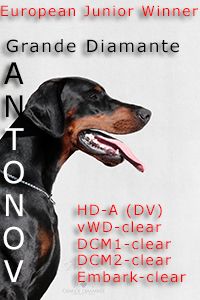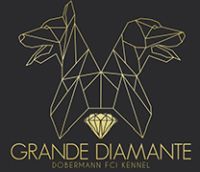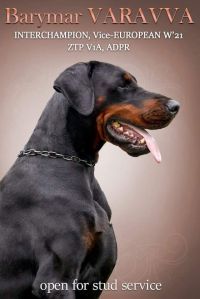FURSTENFELD and FORELL... Two different schools of the dobermann breed?
Author: This email address is being protected from spambots. You need JavaScript enabled to view it. "Diamante Nero" kennel, Italy (click here to view version of article in italian language)
Undoubtedly yes... Mr. Herman Palmer, owner of v. Furstenfeld kennel and Mr. Ernest Wilking, owner of v. Forell kennel introduced various conceptions about the dobermanns breed, however, from genetical point of view, both kennels came from mutual "genetical match". If he will refer to blood-line of black male BD Sg. Alex v. Kleinwaldheim (Ajax v. Simbach x Carola v. Sudharz), born in 1946, we can define him as a common "genetical object". He became an inspiration for further analyses made by breeders and dobermann enthusiasts. Mr. Ernest Wilking Bryan v. Forell Odin v. Forell
Chico v. Forell


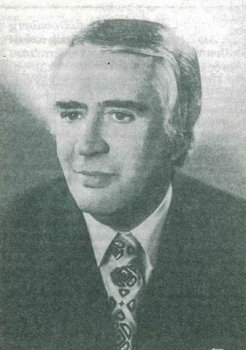
I'd like to emphasize high importance of that male not only because of his genetical power but also to concentrate on his character. He was one of first dogs in 1940's who was able to pass those-times tests and competitions.
Let's verify chronologically development of the breed.
In 1953, in a result of close-related mating with Alex v. Kleinwaldheim, in kennel "v. Hagenstolz" owned by Mr. Maurer was born black male Welt Sg, SchH 1 Lump v. Hagenstolz. His father was Alf v. Hagenfruend (Alex v. Kleinwaldheim x Amsel v. Hagenstolz) and mother Dina v. Klockenhof who was also a daughter of Alex v. Klenwaldheim and Addi v. Hagenstolz (sister of Amsel v. Enstol). 
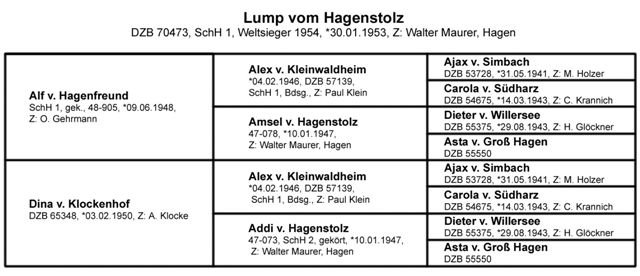
It's clear that the base of "genetical guarantee" of Lump v. Hagenstolz was high coefficient of inbreeding (practically it was between brother-sister). Before I will present the most important offspring of Lump v. Hagenstolz which came from kennel of Mr. Palmer, I would like to stress that I was often guest at Mr. Palmer house and we talked about this special dog - Lump v. Hagenstolz who from his very young age participated at shows and reached big popularity.
In 1956 there was a mating between Lump v. Hagenstolz and black female Inka v.d. Nordburg (Nord Germania x Edda v.d. Nordburg), There was born black male from this combination named Bordo v. Furstenfeld.
In 1958 Mr. Palmer mated black female Int.Ch, BD Sgn, SchH 1 Carmen v. Felsingpass (Igon v. Naunhof x Hede v. Felsingpass) with Lump v. Hagenstolz. In result of this combination he got two very important dogs for the further development of his kennel. Of course I have in mind black male BD Sg, IDC Sg Citto v. Furstenfeld and black female Int Ch, BD Sgn Citta v. Furstenfeld.
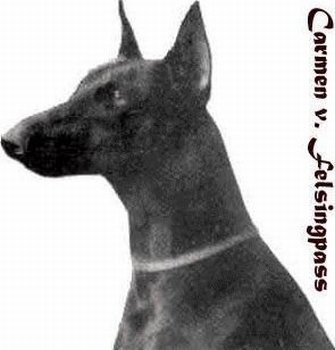

If it comes to Bordo v. Furstenfeld, Mr. Vogel confirmed that this male was endowed with special character and combativness which was more than average. Those features he gave also to his progeny.
I'm convinced that mating between Bordo v. Furstenfeld and Citta v. Furstenfeld which was repeated by Mr. Palmer 5 times (litters K, L, M, U, V) we can define as a crucial one in those days for development of the dobermann breed.
It was very innovative because both parents were directly related with Lump v. Hagenstolz.
Several puppies from that mating were sold abroad, in that case we don't have information about them, some were not appreciated.
Anyway, I'd like to mention about some important progeny coming from above litters - black male born in 1962, SchH 1 Kandy v. Furstenfeld who went to Mr. Leo Schellmann, owner of v. Frankenland kennel. 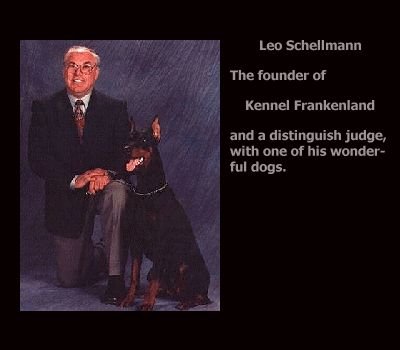
From "M" litter I have to devote my attention to brown male born in 1963 - Int.Ch, BD Sg, SchH 3 - Mecki v. Furstenfeld, to black male Int. Ch Miko v. Furstenfeld and to black female Int. Ch. BD Sgn, SchH 3 Masha v. Furstenfeld who went to Mr. Hans Wiblishauser, owner of kennel v. Bavaria and present President of DV and IDC.
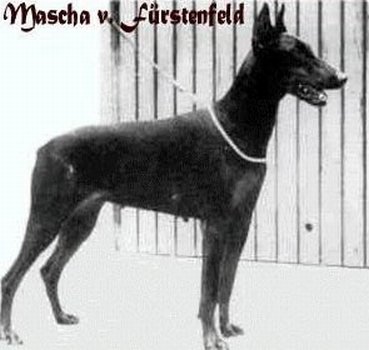
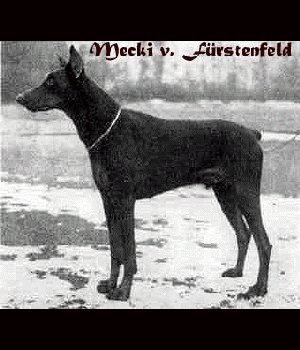

In last "V" litter from 1966, which in my personal opinion was very important, appeared black female - BD Sgn, SChH 1 Vijlia v.
Furstenfeld and male DV.Ch di lavoro, SChH 3 Verry v. Furstenfeld, however, he haven't left some important progeny. Talking about importance of that litter I had in mind black male SChH 3, Korung - Vello v. Furstenfeld who went to Ottmar Vogel, owner of kennel v. Wilden Markgraf, who was also responsible for training dobermanns in Dobermann Verein for nearly 10 years.

To my mind, because of innovativeness in breeding and inventiveness regarding matings, Vello represents new type of modern
dobermanns. How I said before, some matings were closely-related, carefully planned by Mr. Palmer.
I agree with Mr. Vogel who said that this way of selection, in the begining widely criticized, eventually turned blood-line of v. Furstenfeld kennel to create this unusual breed (type). In process of building this line, important role had long-term selection and "genetical -drift". That is how the legend of v. Furstenfeld was born, based on following morfological traits - typical head with very dark eyes, well marked muzzle, special, unique neck - special aspects which determine also other interpretations of Mr. Wilking's and Palmer's kennels. Conceptions of these two breeders had direct influence also for others.
Mating planned by Mr. Wilking in 1968 between Vello v. Furstenfeld and Kira v. Romberg (Bingo v. Dornberg x Ilka v. Romberg) created the most important blood-line in last 30 years (dobermann breed). Regarding black male Int.Ch Bryan v. Forell and brown male Int. Ch. BD Sg, DV Sg Bonni v. Forell and after analyse of the pedigree, we can come into conclusion that both dogs lead to "evolution" in the breed. 

Using the example of Vello v. Furstenfeld, I'd like to express the inventiveness of Mr. Wilking. Making inbreeding based on Alex v.
Kleinwaldheim was able to breed dogs who became so influenced for the future breed development.
In 1964 Mr. Wilking mated black female Iris v. Forell with black male born in 1958 BD Sg, SchH 1 Falko v. Hagenstolz (Lump v.
Hagenstolz x Kitty v. Hagenstolz), female was related to Alex v. Kleinwalfheim. From this combination was born black male Int.Ch,
SchH 3 Odin v. Forell with very strong built, unusual silhouette, so typical for v. Forell dobermanns and became stronger and stronger withing this special type. 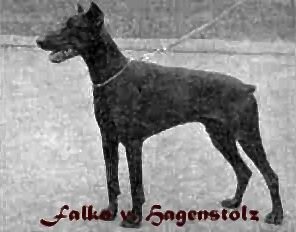
In 1968 also Mr. Wilking made an conclusion of his work and views by doing a mating of Odin v. Forell with brown female BD Sgn Cita Germania (Casar v. Weideneck x Reni Germania), in result black male was born - Int.Ch.BD Sg.DV Sg Chico v. Forell.
Mr. Vogel confirmed that this dog inherited speficic qualities from his father. Mr. Vogel was also personally training this dog.
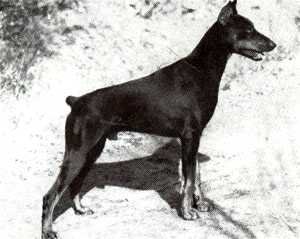

Summing up, I think that Vello v. Furstenfeld (1966) and Chico v. Forell (1968) represent that real aim of two breeders work.
In that way we can say that there is a "genetical balance" who had its influence on the breed, it it "genetical agreement". 















